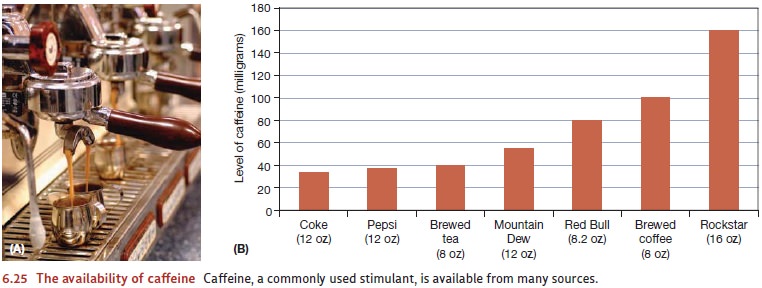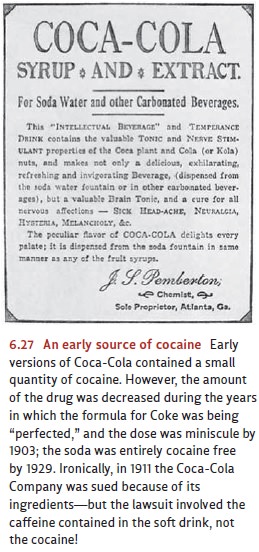Chapter: Psychology: Consciousness
Drug-Induced Changes in Consciousness: Stimulants
STIMULANTS
For medical or recreational
reasons, people sometimes turn to stimulants—drugs
that stimulate the nervous system and
broadly increase the level of bodily arousal. These drugsraise the person’s
blood pressure, increase heart and breathing rate, and certainly increase
overall alertness. Like the depressants, some of the stimulants are freely
available; the most obvious example is caffeine,
which is found in coffee, tea, various colas, and some of the new energy drinks
(Figure 6.25). Other stimulants are more powerful, less available, and in many
cases illegal; the list includes cocaine and various forms of amphetamine, such
as d-amphetamine, methamphetamine, and MDMA (also known as ecstasy). This list
is surely partial, however, because new stimulants are often synthesized to
supply an eager market.

Some stimulants have, or once
had, legitimate uses. Amphetamines, for example, are sometimes prescribed by
physicians to reduce appetite or fatigue, and they’re also prescribed as
treatment for attention-deficit/hyperactivity disorder (ADHD). Ritalin is
another stimulant often prescribed in treating ADHD. Cocaine was used for many
years as a local anesthetic for ear, nose, and throat surgery; it’s still used
for some surgical procedures. (Novocaine, a more widely used anesthetic, is a
close chemical cousin of cocaine.) However, all of these stim-ulants are often
abused as recreational drugs. People use these drugs to boost their energy,
mood, and sense of confidence; to decrease the need for sleep; and to improve
athletic performance. These benefits may come at a high cost, though, because
stimulant use can lead to physical and psychological dependence. What’s more, a
regular user who abruptly stops using one of these drugs is likely to
experience powerful withdrawal symptoms including fatigue, irritability,
depression, headaches, and more.
Heavy users of methamphetamine
often end up smoking large quantities of this stimulant. They gain a rush of
energy and pleasure from inhalation and typically feel elated, confident, and
able to stay awake several hours past their usual sleeping time. However, this
aroused state is associated with markedly higher blood pressure that can
increase the user’s risk of heart failure or stroke (Figure 6.26). And,
inevitably, the per-son will reach the end of this aroused period and come
crashing down. At that point, the person is likely to become depressed and
irritable, and sleep for days.

Cocaine is another commonly
used—and abused—stimulant. This drug, derived from the leaves of the coca
plant, is usually snorted or inhaled and quickly enters the
Pp
bloodstream, causing a rush of
excitation and euphoria (Figure 6.27). Once again, though, this rush is only
temporary. The subsequent crash—as with amphetamines—can involve feelings of
fatigue and depression. And here too, long-term abuse can bring with it a set
of problems that include risk of dependence, feelings of paranoia, and an array
of medical difficulties including cardiac arrest and respiratory problems
(Franklin et al., 2002; Gourevitch & Arnsten, 2005).
Another often-abused stimulant is
methylenedioxymetham-phetamine (MDMA; also known as ecstasy). MDMA is a
molecule synthesized in the lab; chemically, it resembles another stimulant—
methamphetamine—as well as the hallucinogen mescaline.
MDMA is a drug often taken in social settings (at clubs or a rave) and produces
an emotional elevation that involves feelings of pleasure, elation, and
warmth. MDMA is also a mild
hallucinogen and produces a strong sense of empathy and closeness to everyone
who is around.
Once again, though, there’s a
price to pay for these benefits. When people are using MDMA, they are likely to
become dehydrated and to clench their jaws so tightly that they can damage
their teeth and jaw muscles. In addition, and like other amphetamines, MDMA
users are susceptible to substantial increases in blood pressure, pulse, and
body temperature. This situation can put the user at greater risk for cardiac
complications (e.g., heart attack) and/or stroke. When the MDMA wears off
(typically, after 3 or 4 hours), the person may also experience a kind of
rebound that makes him feel sluggish and depressed. And at least some research
suggests that continued use of MDMA can create a risk for several other
problems (Biello & Dafters, 2001; Morgan, 2000; Pacifici et al., 2001)—
including impaired memory, problems in one’s body clock that may include sleep
difficul-ties, and weakened immune system function (and so greater
vulnerability to illness).
Overall, it seems clear that
these stimulants do change a person’s conscious experience. Excitement,
euphoria, and increased self-confidence all powerfully color his experiences,
and the stimulants may produce a sense of enhanced awareness that changes how
the world looks, sounds, and feels. The strong sense of empathy produced by
MDMA also adds a pleasurable dimension to one’s experience. But as we’ve seen,
these drugs expose users to serious health risks including life-threatening
medical conditions, a danger of addiction, and a catalog of medical, mental,
and emotional difficulties associated with long-term use.
Related Topics